The last generation Russian Main Battle Tank
The T-14 "Armata", also known under its industrial designation as "Ob'yekt 148" (Объект 148) is the latest generation Russian main battle tank, and arguably a very innotaive design. The name derives from the Armata Universal Combat Platform, also declined into a multitude of other designs. This is the first series-produced next-generation tank. The Russian Army planned to acquire 2,300 of them as for 2015, until 2020. However finances problems delayed the order until 2025, before the cancellation of the entire production run. Only a batch of 100 has been delivered so far, deployed with the 2nd Guards Tamanskaya Motor Rifle Division, in planned service for 2022. State tests are still ongoing. Nevertheless, the tank at first shocked the west when first revealed, using concepts that were in total break from Soviet-era designs. However as information seeped-in, that fear mitigated and countermeasures were adopted by NATO. After all, the T-14 Armata did not even trigerred a strong reaction like announcing a new MTB, but perhaps a Franco-German project for the far future... History will tell.Background
The war in Chechnya which saw catastrphic losses of the latest Russian MTB (badly used in urban combat however) and the T-90 along with several concepts for a future design motivated for the contruction of a brand new generation tank, in complete rupture with pas designs. After all, the current T-90, Russia's main battle to date is based on the T-72, a 1970 design. More than fifty years has passed since, a gap comparable as in between the Renault FT (1917) and the T-63 (1961). The T-72 was a third-gen, and the T-90 a 3rd/4th-gen transitional MBT, so the new tank was announced to be of the "5th generation". Even though the concept itself was a bit too theoretical at that time, as remains so today. Constant upgrades made other 1970s milestone tanks such as the M1 Abrams and Leopard 2, fourth-gen tanks as of the 2000s, but their core concept remained fundamentally unchanged. Autoloaders were not the norm, standard fully-crewed turrets were, and armour did not changed much since the invention of ERA, after composite and modular armor.
The commander is in the right side position, the driver in the left.
The last large tank battles in the Gulf in 1991 did not changed much these core concepts, if not that optics were needed to be up-to-date and stabilization systems also. The "fourth gen" MBT integrated however protection for urban combat rather than a design made for the great plains, the bedrock of NATO designs of the third generation. 4th Gen. received updated protection against Manpads, mines, remote weapons systems (RWS), improved warning systems and laser detectors, fully automatic smoke mortars, ECM and light diffractors, advanced stealth for IR signature, and of course, digitalized battlefield management system plus GPS/navsat and navcom. Amonth 4th gen MBTs let's cite the Japanese Type 10 (2012), South Koran K2 Black Panther (2014), M2020 from North Korea, Altay from Turkey or the NTDS Main Ground Combat System (2035). For all observers, the Russian T14 is one of these 4th gen. So what a true "5th gen" could bring ? The question is widly open to debate.
There are more of less-far fetch prospective 5th gen concept out there, but ideas around the next and among exports gives the following: Larger guns (140 mm), special ammunition for extra long range ballistic fire and submunition to replace traditional self-propelled artillery, larger cannon-fired missiles models with triple charges, kinetic energy electric cannons (with mini-nuclear reactor), fully-automated netw-gen RWS with 20 mm, cal.50 and 30 Machine-guns, extra roof protection or of course entirely remotelly operated turret (the T14 features), active stealth cover (using electric light diffraction), air and ground drones for reconnaissance, and of course fully-automated tanks. It's FY2030-2040 tech at the least.
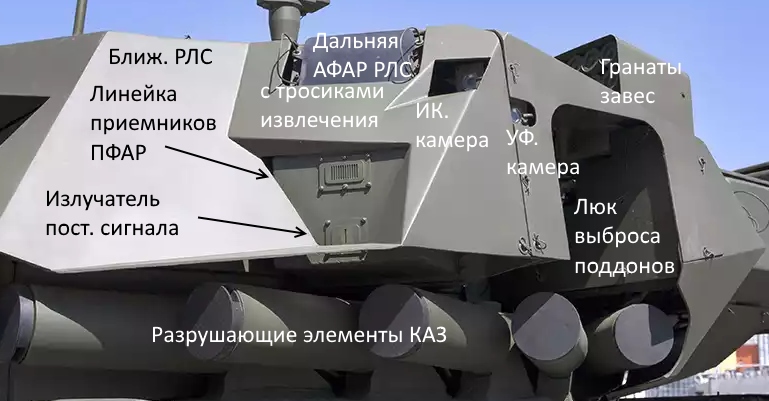
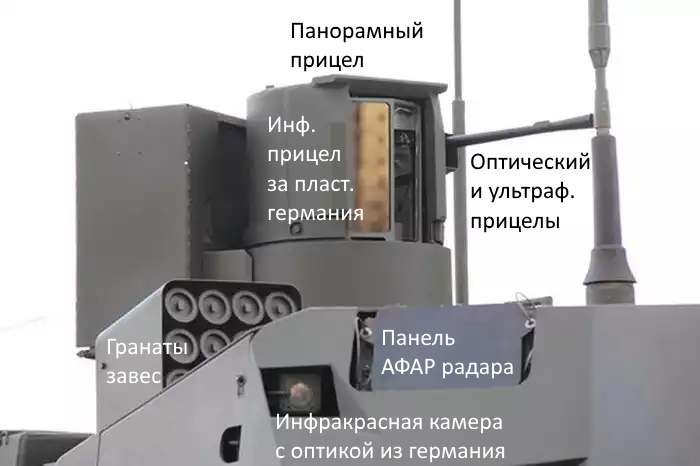
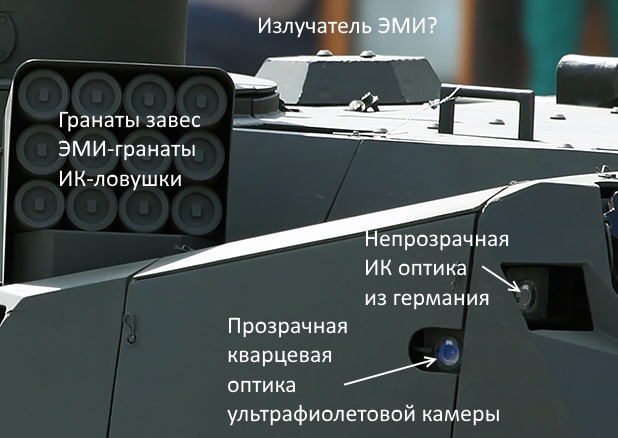
Details about the T-14 turret
About the Armata platform
The core of the design was the Armata platform. In the Soviet era, tanks were designed not from a platform but rather to answer specifications related to the main combat performances of the tank, not with standardization in mind. The latter came afterwards as specialized vehicles were derived from this platform. In Europe, probably UK went far into the "common" or "universal" patform to a larger degree in the 1960s and 1970s, partially achieved. The problem with the common platfor: concept is that to help future standardizations, some traeoffs and compromises had to be done which could hinder the MBT. For this reasons the concept was only applied for light tracked vehicles.However, the Russians revived the concept of universal platform for a heavy vehicle, enabling the MBT and heavy self-propelled artillery, plus the heavy IFV, a concept which she also pioneered. The designation was "prospective family of heavy unified battlefield platforms" in Russian. Its name "Armata" derived from the Latin plural "arma" (weapons of war) and old 14th century name for guns as well as the Greek "Arma" for "chariot". Behind this marketing term, the concept as a combat platform was developed since 2009 by Uralvagonzavod headquartered, Nizhny Tagil. Prototypes were presented at the defense exhibition Russian Arms Expo in September 2013 wih mockups and the first operational prototype revealed on this platform was in November 2014, the first trials of the 2S35 Koalitsiya-SV self-propelled gun.
The first pre-production vehicles of each of the three branches were shown for the first time to the public in the 2015 Moscow Victory Day Parade, surexposed by the Russian media announcing optimitic delivery dates in in 2015/2016. Russian Lieutenant-General Yuri Kovalenko declared that this platform resued many features of the abandoned T-95 tank prototypes. The main battle tank variant featured quite a unique concept at that time, a full separate "cell" or crew compartment under the remote turret. This was one of many improvements. The vehicles of this Armata platform were also supposed to be given also the radar and tech from the Sukhoi Su-57. The Ka band radar (26.5–40 GHz) AESA radar was announced to be delivered in 2015.
All vehicles were also to use a new type of lightweight armor called 44S-SV-SH. It was developed by the Steel Scientific Research Institute enterprise. Crucially for Russian conditions, it was very insentiive to exytreme temperatures, notably in the cold (when metal becomes brittle). Remote weapon station and automated control systems are also part of the common package. Other vehicles are under development such as the BREM-T T-16 Armoured recovery vehicle ("Object 152") and BMOP "Terminator-3", while many other projects are under development, such as the USM-A1 Combat engineering vehicle, BMO-2 Heavy armored personnel carrier for flamethrower-squads, BM-2 Large multi-barrel rocket launcher/TOS-2, TZM-2 Reloading vehicle for the TOS-2, MIM-A Combat engineering vehicle, MT-A Armoured bridge layer, UMZ-A Combat engineering vehicle, PTS-A Tracked amphibious vehicle, or the 2S12A/2B11 Sani mortar towing vehicle. As of today (June 2021), all three vehicles delivered amounts to 144: 100 T-14, 32 T-15, and 12 2S35 SPGs. Barely a way to scare the west.
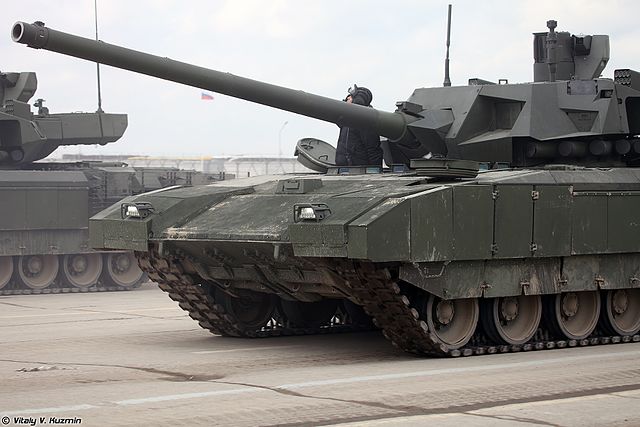
T-14 by Vitaly Kuzmin
Development of the T-14
The shining crown of the whole Armata program was of course its main battle tank, which certainly magnetized the international press as expected, speaking of Russia new unstoppable "secret weapon" making all western tanks obsolete overnight as the Dreadnought did with battleships in 1906.Like all modern Russian or Chinese weapons system, tight secret meant details of the design development are not known with certainty. Details are simply unknown and only crossed between public announcement from the Russian MoD, bribes of information by the manufacturer, and second-hand informations, plus western experts observations. The Armata was designed over five years, which was short in order to feature quite a number of innovative characteristics. The an unmanned turret and protected cell for the crew are unmistakably its most captivating. Like previous designs using an atuoloader, and still with low-profile traditions, the crew remains of just three men, seated in a single "armoured capsule", at the front of the hull so as for the driver being kept in close proximity from the commander and gunner. Also unusual for soviet-inherited crudeness, and disregard for crew comfort, the T14 features a toilet for the crew... Rather to try to cite the development phases, let's go directly into the design of the beast:
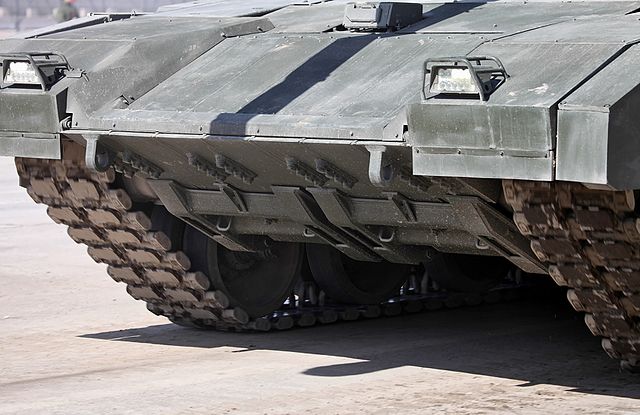
T14, Front close details, Alabino, 22/04/2015
Design
Motorization
Let's start with the usually less innovative aspect, related to the powerplant and mobility of the tank. The T-14 is powered by a ChTZ 12N360 (A-85-3A) diesel engine. It is almost twice as mowerful as T-72 engines, delivering up to 1,500 hp. It's theoretical maximum power, particically never used, is 2,000 hp. It still could be obtained in cases of war and emergency, but at the cost of radically decreasing its service life. At last, Russian tanks motorization reached the international standard for modern MBTs. The engine is alleged to be driven for 10,000 hours straight at 1,200 hp governed. It is electronically controlled to ease the driver's tasks. It also gives the T14 an operational range of over 500 km.This A-85-3A used a 12-speed automatic gearbox. It is capable of reaching 80 to 90 kilometres per hour (50–56 mph) maximum (again, 90 to 100 in emergency), with a range of 500 kilometres (310 mi). Details are not known but some experts think that its transmission could be electronically controlled, procuring external reverse and demultiplier gears for an equal forward and reverse gear range. Hydrostatic transmission is also rumored. However it is alleged publicly that this transmission is joined with the engine into a single unit, allowing to change the entire system in the field under 30 minutes.
Mobility
The T-14 departs from previous designs, since the T-64, by using brand new intermediate 70 cm diameter road wheels. Another feature is the electronically adjustable suspension on at least the first two roadwheels, the last ones possibly also. In 2015 during the Moscow Victory Day Parade rehearsal video, One of the frontal first wheels was rectracted during turns suggesting a partial hydraulic suspension system using a lever arm shock absorber doubling as suspension actuator. This enablng previously unseen pivoting abilities and as forms an active suspension system also improving the target lock time by 2.2, allowing shorter recations between its detection and reaction, by 1/3. Much of this is however speculative and based on observations only. Nevertheless, the T-14 mobility is rather excellent in regard even of previous design, rather light compared to western designs: With a mass of 48 tons, the T14 has a favrourable power/weight ratio and is still transportable rail or trailer, and remained compatible with all main bridges in Russia. Two T-14s and crews were tested airlifted by the Antonov An-124. The smaller Il-76 can only lift one T-14. Trials are still ongoing so all-terrain figures remains unknown, although fording capacity remains comparable to previous designs, as climb rate improved thanks to the larger output. Both water crossing with and without preparation are possible, although no photo shown a fully prepared T-14 crossing a river exist yet.Armament
The meaty part of the design is still somewhat traditional, although featuring many improvements pioneered in recent export models.Main gun:
This is the 2A82-1M 125 mm (4.92 in) smoothbore cannon. Not a revoluition, this is just an upgrade for the 2A46 125 mm gun seen in the T-90. According to Russian sources its muzzle energy is far greater even compared to the Rheinmetall 120 mm gun. The striking aspect is the absence of a fume extractor, due to the fact it's carrie dinside unmanned turret: Exhaust gasses could be extracted in separate channels upwards and remaining toxicity inside the automated reload system is not an issue, but heat perhaps.The fire rate of the 2A82 is allegedly to be from 10 to 12 rpm. The autoloaded uses a left side casing ejection port. No details are known about the working details of the reload systems, although removing the crew, yet again allowed designers to simplify or elimniate many safety features. The main problem however would be in that case a jamming, as the crew has no seasy access into the turret to solve the issue.
The maximum effective penetration range is 8 km with gun-fired ATGMs only. The 2A82-1M 125 mm cannon itself can fire at maximal two kilometers for best accuracy. The autoloaded can load all sorts of ammunitions in the Russian inventory, the armour-piercing fin-stabilized discarding sabot (APFSDS), high-explosive anti-tank (HEAT-FS), air-burst HE-Frag shell and practice rounds. The Vacuum-1 APFSDS round is brand new, made for the T-14 gun, and is fitted with a 90 cm long rod penetrator, which is unusually long. It is said to be capable of penetrating 1 m of RHA equivalent at 2000 m. The new Telnik HE-Frag shell is also provided, and is a controlled-detonation round. Also stored inside and usable are the last-gen 9M119M1 Invar-M ATGM which range is between 100 m and 5 km. It was also tested against low-flying air targets (such as helicopters). The new 3UBK21 Sprinter ATGM also available is even better for this, with an effective range of 12 km making it the official Russian tank "heli-killer". The 3UBK25 uses active homing, but it's still under development.
It is not known precisely how much rounds or ATGMs are carried inside the turret. Giving the larger turret and previous practice, the figure of 45 is usually accepted, 32 in the autoloader and the remaining in stowage bins usable for the crew to reload the barillet.
Secondary:
The main secondary armament is a 12.7×108mm Kord (6P49) machine gun. It is provided 300 rounds and placed in the larger RWS of the turret, on the left side. It is completed by a front-mounted 7.62×54mmR Pecheneg PKP (6P41) or PKTM (6P7К) and supplied with 1,000 rounds, with another 1,000 rounds stored separately. The 12.7 mm machine gun is above and integrating the roof-mounted commander's sight, avoiding visual obstructions. The turret front's slit that is speculated to let the 7.62 mm MG pass through. The turret is allegedly also able to be fitted with a Shipunov 2A42 30 mm cannon enhancing its anti-air and urban combat capabilities, even low-flying, low-speed planes (such as the A-10 thunderbolt).Future upgrades:
Probably the most important announcement by the MoD in 2016 also was a projected upgrade to 152 mm in the future, although this is probably conditioned to the German gun upgrade project to 140 mm recently. The 2A83 152 mm gun is currently indeed in development. It was at first designed in 2000 for the T-95 and fires a tailored high-speed APFSDS shell, to 1,980 m/s. Russian engineers however moderated the upgrade likeness, arguing that the larger caliber only brings limited improvements into an already winning recipe and in general, a larger caliber would disrupt the Russian supply chain entirely. Another AA development is a more advanced anti-aircraft missile, which in complement to the extra 30 mm gun would make any SPAAG superfluitous at tank brigade level.Protection
Passive protection systems:
Crew's armoured capsule
Probably the best-known and liked aspect of the design is the famous "coccoon" prepared for the crew, only possible because of the autoloader, and naturally the remote turret. Protruding, the turret always has been a prime target for any adversary. In comparison, the lower crew cell is protected by the glacis to the front, and engine at the back, plus improved layers of protection for the sides. Access to this capsule is the same as for the driver previously, via the front hatches (driver and commander). No access from the turret's roof. It's assumed a small trap also is placed below the capsule to escape the tank when toppled over or if the hatches are obstructed. When the crew is inside the air-conditioned capsule, seated in tandem for better communication, they have at disposal digital screens with all vital informations and interactivity. The commander is scanning its remote cameras and main sight (including an IR mode), the driver sees the frontal arc also via cameras and the gunner sees the target but also could choose its amunitions and sees also the interior of the turret and reloading operations.Next-gen ERA
Both the chassis and turret are equipped with the Malachit dual-explosive reactive armour (ERA) system on the front, sides and the top.We can tell however it comprises a large amount of ceramic, temperature resistant. Serial production of the Armata Platform's ceramic armor components was announced indeed to start by mid-2015.Semi-active stealth and coating
Another MoD claim in 2015 is that the T-14 would be invisible to radar and infrared detection. The hull is covered with a radar-absorbing paint (probably derived from that of 5th gen jets) while most detection-sensitive components with heat signatures are buried deep within the hull. The turret's shape itefl as it appeared obvious for observers, is shaped to be stealthy, reduce its radio and thermal signatures as well as bouncing radar waves. Experts of all sides however expressed serious doubts about the stealth level of the T-14. A retired senior U.S. military officer that modern thermal technology could detect anything emitting heat, wether its placement into the hull or turret. It is also alleged that the ideal tech for a ground vehicle would be to make it indistinguishable from ground clutter and optimize its air-to-ground detection cover, techniques that does not overlap. The Pravda almost claimed the T-14 met the "principle of six zones": 1- the Afghanit system for detecting incoming rounds, 2- Supposed stealth/IR characteristics, 3- Avoid target acquisition by ECM/jamming, 4- ERA system 5- Passive armor, 6- Protected capsule.Active protection systems:
Afghanit Protection system
The T-14 Afghanit (Афганит) active protection system (APS) includes a millimeter-wave radar able to detect and track incoming anti-tank munitions, wether kinetic energy penetrators or tandem-charges projectiles. The maximum speed of incoming interceptable target is 1,700 m/s or Mach 5.0 but upgrades aimed t bringing this to 3,000 m/s (Mach 8.8). It protects the tank from all sides and still the upwards sector is hard to defend. The T14 is still vulnerable to top-attack munitions.Defense Update released an analysis of the tank in May 2015: For them the Afghanit's main sensors appeared to be the four panels mounted on the turret's sides, likely to be the AESA radar panes creating a 360° view. Another was possibly mounted on top of the turret. The system could mount a hard kill and soft kill, the first actively destroys an incoming projectile, the second being a jamming element, confusing guidance systems. They are effective agains 3/4th gen ATMs, such as the Hellfire, TOW, BILL, Javelin, Spike, Brimstone, and JAGM and sensor-fused weapons. Russian sources claimed it's effective against depleted uranium-core APFSDS rounds up to 2 km/s. Russian MoD also alleged practical tests confirming the destruction of such projectile uranium but western analysts remain skeptical, as it's all internal claims.
The hard-kill five launchers tubes per side are protruding between the turret's front sides and chassis. They have an electronically activated charge. The warhead type is undisclosed. Analysts assume it to be a HE with fragmentation charge or an explosively formed penetrator (Russian patent RU 2263268).
The "soft kill" part of the Afghanit defense system is the NII Stali Upper Hemisphere Protection Complex consisting of two steerable cartridges, each with 12 smaller charges plus the turret-top VLS having two more cartridges for illumination and jamming of guidance systems. It is also alleged by combining the AESA radar and heavy AA RWS MG or 30 mm gun it is also possible to destroy directly incoming missiles or slow-flying shells, basically like a CIWS.
Threat management system
Inside the capsule there is also the integrated, computerized control system monitoring the state and functions of all tank modules. The software analyze threats in real time, suggesting or automatically taking actions to eliminate them, short-circuiting the crew's decision time, but also without an immediate external threat, detect and rectify crew errors. While very advanced, it is unknown how much of it can be disabled or to get back manual control. It's a complex system that certainly motivated to push back the development of the tank into active service, perhaps more than actualy budgetary restraints.Communication and battle management systems
The T-14 is given a 26.5–40 GHz active electronically scanned array radar used by the Afghanit. The computer is allegedly able to track silmultaneously 40 airborne or 25 ground targets, down to 0.3 m in size, so large drones. Max range is allegedly 100 km. The smae tracking system provides automatic firing solutions for destruction of incoming targets. They are transmitted dependng of the threat size, range and speed either to the APS or main gun control computers. The system coud be used also for target designation for artillery or air defence and reconnaissance roles to some measure. Of course, highly protected communication channels are used for dataling between tanks and up to brigade command post level.This system however does not tells if multi-targeting/actions are automated or not. The idea there is to integrate systems comparable to the AEGIS developed for USN destroyers in the 1980s and now mainstream in the latest generation fighters. Given the capabilities of the T-14, would it be possible to locate and terminate at the same time, let say in an urban combat situation, a sniper forward at 1500 m using the front hull MG, a RPG infantry posted at the 5th floor above the tank with the heavy RWS, a light armored vehicle approaching with the 30 mm gun, and another approaching helicopter with the 3UBK25 ATGM, then APCs with HEAT rounds and then adressing a column of enemy tanks arriving in reinforcement at 2000 m from another street hidden from view (so via satcom-data) ? Future will tell.
The commander and gunner have very similar identical multispectral image sights. The visible electromagnetic spectrum and thermography channels as well as laser rangefinders data are all communicated the same way on the displays. The commander's sight (tutter top left, 360° FoV) and gunner's sight (turret's niche left of the main gun, slaved to it) could be enhanced by a direct-vision periscopic channel and laser designator. The latter could be used for the T-14's SACLOS ATGMs. Detection range for the sight (for a tank or large AFV) is about 7,500 m (8,000) in daylight using a remote TV/periscopic channel, and down to around 3,500 m in night vision by using the thermal channel. The backup night-vision sight allows a shorter range, about 2,000/1,000 m respectively. The driver is also given a forward looking infrared camera and several closed-circuit television cameras also available for the commander to scan around the tank, providing an all-round vision for the entire crew. The 360-degree camera coverage is made available at all time for the crew clustered in the front of the hull. The problem however is what happens in case these cameras are obscured in any way. These next-gen sight capabilities has been controversial until 2016, the Krasnogorsk plant finished testing the Irbis-K night-vision sighting system, first Russian-produced mercury-cadmium-telluride (MCT) matrix thermal sight, allowing day/night detection up to 3,240 m.
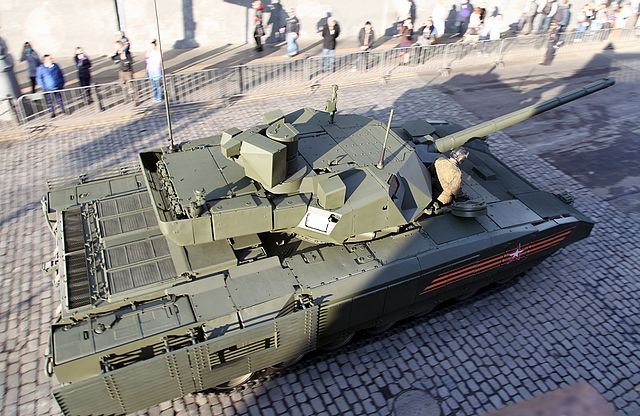
T-14 roof over top view
Production & controversy
Preliminary reports in 2014 sais the T-14 Armata was to be less radical and ambitious than the T-95. It was lighter, more agile and more affordable. Also all the T-14, T-15 IFV, Kurganets-25 and Bumerang IFV all coud receive the same 30mm Bumerang-BM RWS. The tank's unmanned, remotely controlled turret, digitally controlled is believed to be the base for the development of a fully robotic tank. It has been speculated that some components may be of foreign (non-Russian) origin, as revealed by pro-Ukrainian hackers, like the night-vision systems attempted to ebe purchased from a French supplier. Nevertheless, with the sanction inflicted to Russia this is very unlikely it could happen as of today.When first revealed, T-14 Armata was described by the press as a major concern for NATO and Western armies. British intelligence notably praised the unmanned turret. However since it's debut, Western observers constantly express serious doubts about Russia acquiring numbers of T-14s to equip entire brigades. Indeed, the initial order of 2,300 vehicles, at first postponed, has been changed to an order of 100 vehicles of pre-production, until economic conditions allows further production.
In Germany, the Armata trigerred a response from Rheinmetall AG whch publicly announced an earlier development for a new 130mm L/51 tank gun, claiming a 50% armor penetration increase over the 120mm L/55. Both German-French NTDS recent fusion led to an unspecified "Main Ground Combat System", to compete, replacing both the Leclerc and Leopard 2 in the 2030s. As time passes it appeared however that the small numbers of the not-so costly T-14 (estimated $3.7 million versus 4.5 Million for the T-90SM) make it similar to many other "prestige tanks" or nations such as India (with the Arjun), Japan (with the Type 10), China (Type 99), Turkey (Altay) and Korea (K2), produced locally in small numbers and at great cost as a matter of pride.
Service as of today
Initial plans stated a grand total of 2,300 T-14 MBTs expected to be supplied by 2020. They were expected to modernize 70% of the Russian tank park, with Uralvagonzavod rolling out around 500 T-14 yearly. By 2017, the order was scaled back to a test batch of 100, starting in 2020 and up to 2025. As presentely, about 25 vehicles are seemingly active. The first T-14 were displayed with great fanfare (including one whic apparetntly "broke down) at the 2015 Moscow Victory Day Parade. They were observed also at the practice drill run on the Alabino training grounds, with their turrets covered.A solution to allow the MoD to finance further orders, by mitigating the R&D cost, using export sells: To Egypt for example, as declared by Denis Manturov, Russian minister of trade and industry in an interview with RIA Novosti on a visit to Cairo in May 2015. A sale prospect was announced and discussions with Egypt to delivery T-14 after completing its state trials and full service acceptance. Company director Oleg Sienko also announced an Egyptian delegation was invited in September 2015 to see the tank in trials.
Vladimir Kozhin (Russian presidential aide) also declared to Izvestia that China and India expressed interest in purchasing the AFVs showcased at the May 9 Victory Day in Moscow, notably the T-14. "To a larger extent it is our traditional partners: India, China and South-East Asia" Norinco however in China claims their VT-4 is superior. Vietnam is a potential customer as well as Belarus but no action has been taken, at least known so far, COVID19 events also considerably slowing these prospects down.
T-14 related links & resources
The T-14 on WikipediaArmata platform
On army-recoignition
On defense-update
4th gen tanks definition
Prod. announcement on thediplomat.com
DU analsys
Extra photos
More photos (cc)
T-14 Armata specifications | |
| Dimensions (L-w-h) | 8.7 x 3.5 x 3.3m (29 x 11 x 11fts) |
| Total weight, battle ready | 55 Tons (110,000 lbs) |
| Crew | 3: Cdr, Driver, Gnr |
| Propulsion | 1,200/1,350/1,500 hp–2,000 hp Diesel |
| Speed (land/water) | 80 kph (50 mph/56 kph) |
| Range (on flat) | 500 km (310 mi) |
| Armament | 2A82-1M 125 mm (4.92 in) smoothbore cannon Sec: 1x 12.7 mm (0.5 in) Kord, 7.62 mm (0.30 in) PKTM 9M113 Konkurs ATGM (4 reloads). |
| Armor | 44S-sv-Sh Steel, modular, classified |
| Total production | 100 |
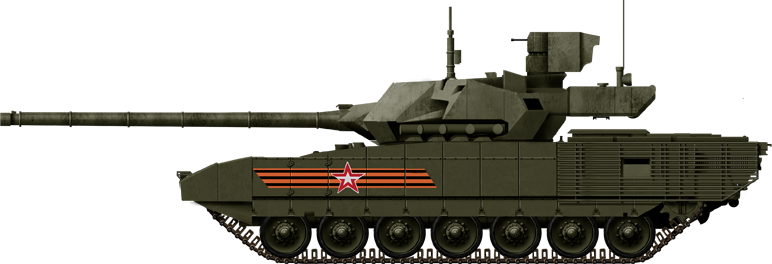
The T-14 Armata as revealed in Moskow's May 2015 parade, for the 70 years of the victory ovet the axis.
Video
Extra photos
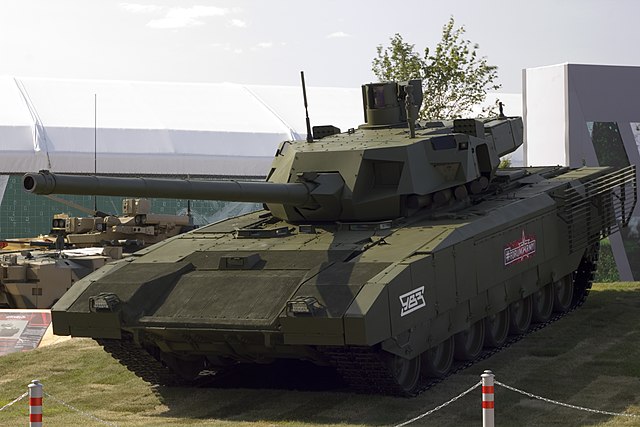
Т-14_Factory-expo-model

T14-Ft-view-VKuzmin-Alabino 05/04/2017
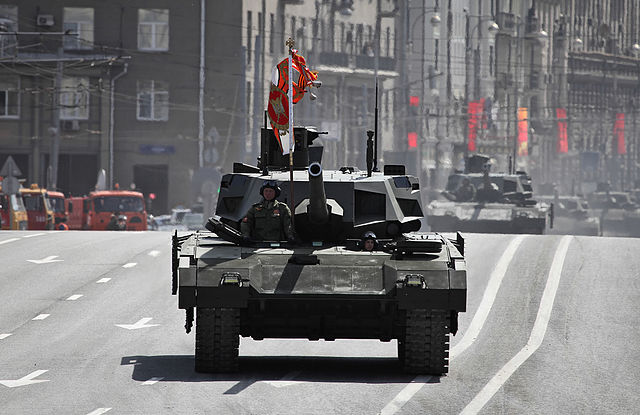
T14 Front 9 may 2015, Moscow
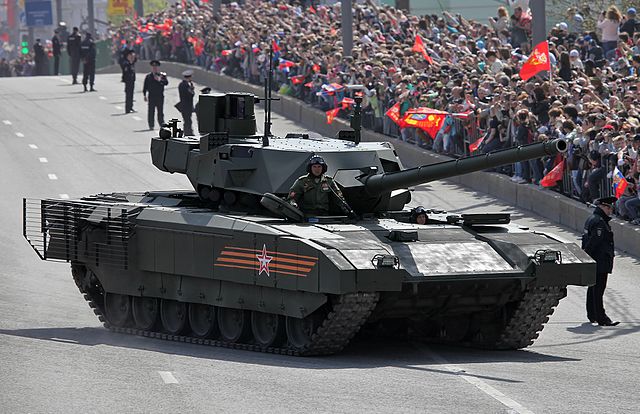
T14, 9 may 2015 Moscow
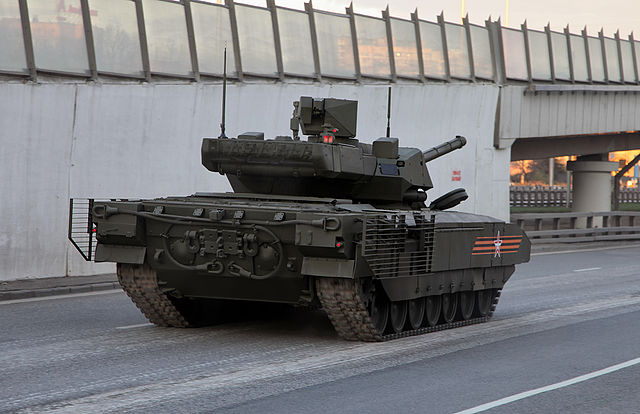
T-14 rear, 4 may rehearsal
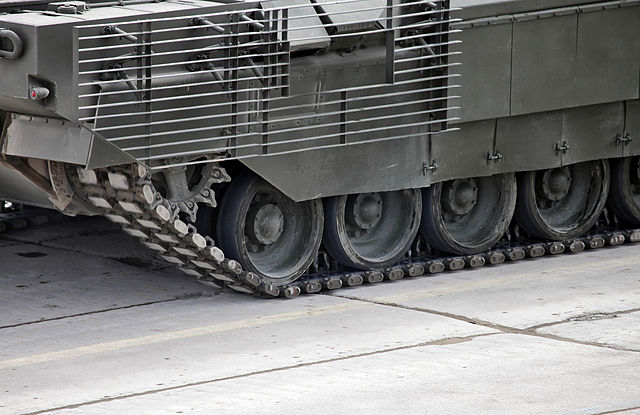
T-14 close rear Alabino 22/04/2015
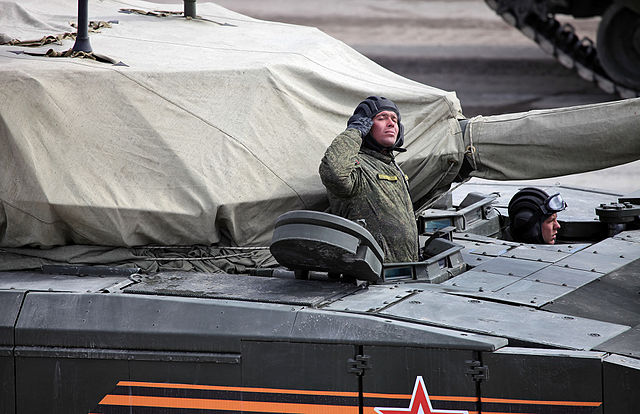
T-14 masked turret, Alabino, 22/04/2015
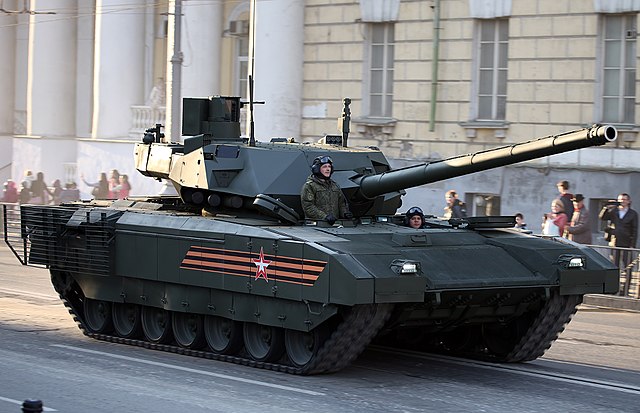
T-14 V-Day Rehearsal, 05/05/2016
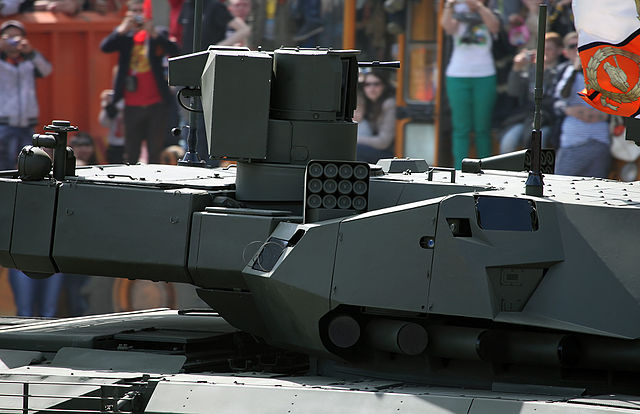
T-14 Turret, 9 May 2015, Moscow
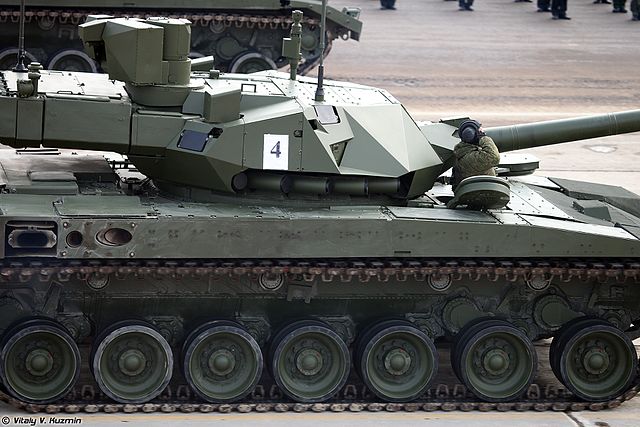
T-14, without skirts, Alabino 11/04/2016
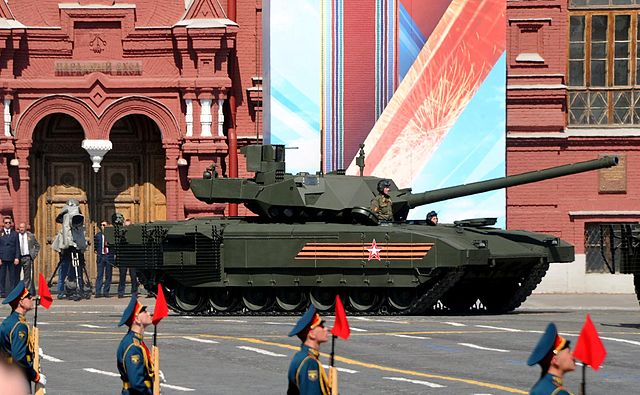
T-14 Military parade on Red Square, 2016/05/09

Modern Tanks
Modern MBTs posters

Denel Bagder (2018)

Type 16 MCV (2016)

Gepard 1A2 last rounds 2011

SANDF

Russian AFVs

Main Battle Tanks
